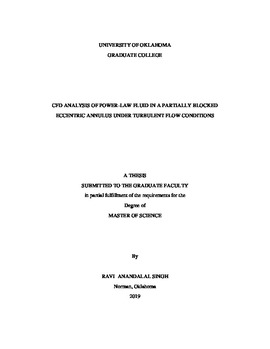| dc.contributor.advisor | Ahmed, Ramadan | |
| dc.contributor.author | Singh, Ravi | |
| dc.date.accessioned | 2019-12-17T19:16:49Z | |
| dc.date.available | 2019-12-17T19:16:49Z | |
| dc.date.issued | 2019-12 | |
| dc.identifier.uri | https://hdl.handle.net/11244/323246 | |
| dc.description.abstract | An increase in hydrocarbon production by the application of several laterals from a single vertical wellbore is now a widespread practice. Horizontal and inclined wells are drilled at record lengths, which once seemed impossible for both onshore and offshore locations. However, well inclination causes eccentric geometry in the wellbore. The eccentric annulus results in a velocity distribution with stagnant zones that make hole cleaning inefficient which leads to the formation of stationary cutting beds and partial blockage of the annulus. These undesired bed development restrict the fluid motion by providing hydraulic resistance and thereby affecting the bottom hole pressure, which in turn influences the efficiency of the drilling operation and increases the non-productive time.
This research focuses on analyzing the fluid motion in a partially blocked eccentric wellbore using the Computational Fluid Mechanics (CFD) approach. A commercial software ANSYS Fluent is used to perform the CFD analysis. The study is conducted considering the flow of power-law fluid in eccentric annulus under turbulent flow conditions. Different flow geometries are created by varying the blockage height and diameter ratio. The pipe is considered highly eccentric (90%) for all cases. The fluid properties are varied by altering the consistency index and the fluid behavior index and analyzing their impact on the velocity profile, pressure loss, wall and bed shear stresses.
Observations are made with respect to pressure loss and shear stress. The annular pressure loss increases with cutting bed height at a given flow rate. Furthermore, at a constant flow rate, the higher the shear-thinning property of the fluid, the lower is the effect of cutting height on the annular pressure loss.
CFD simulation results are evaluated by comparing with available experimental measurements and the predictions of existing models. The pressure losses predicted using CFD are predominantly in agreement with experimental measurements. After verification and validation, CFD simulation results are utilized to develop an approximate correlation for dimensionless bed shear stress. The developed correlation exhibits a discrepancy of about ±10% against simulation results. The correlation helps optimize hole cleaning and wellbore hydraulics. | en_US |
| dc.language | en_US | en_US |
| dc.rights | Attribution-NonCommercial-NoDerivatives 4.0 International | * |
| dc.rights.uri | https://creativecommons.org/licenses/by-nc-nd/4.0/ | * |
| dc.subject | CFD | en_US |
| dc.subject | Eccentric Annulus | en_US |
| dc.subject | Power law fluid | en_US |
| dc.subject | Turbulent Flow | en_US |
| dc.subject | Partially Blocked | en_US |
| dc.title | CFD Analysis of Power-Law Fluid in a Partially Blocked Eccentric Annulus Under Turbulent Flow Conditions | en_US |
| dc.contributor.committeeMember | Vedula, Prakash | |
| dc.contributor.committeeMember | Karami, Hamidreza | |
| dc.date.manuscript | 2019-12 | |
| dc.thesis.degree | Master of Science | en_US |
| ou.group | Mewbourne College of Earth and Energy::Mewbourne School of Petroleum and Geological Engineering | en_US |
| shareok.orcid | https://orcid.org/0000-0001-6442-2366 | en_US |
| shareok.nativefileaccess | restricted | en_US |

